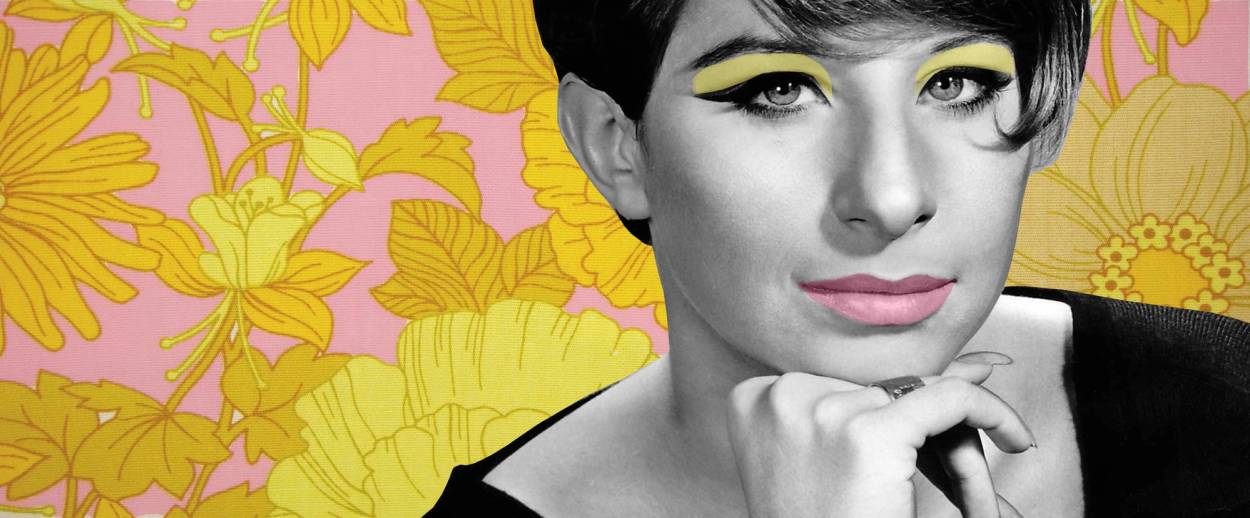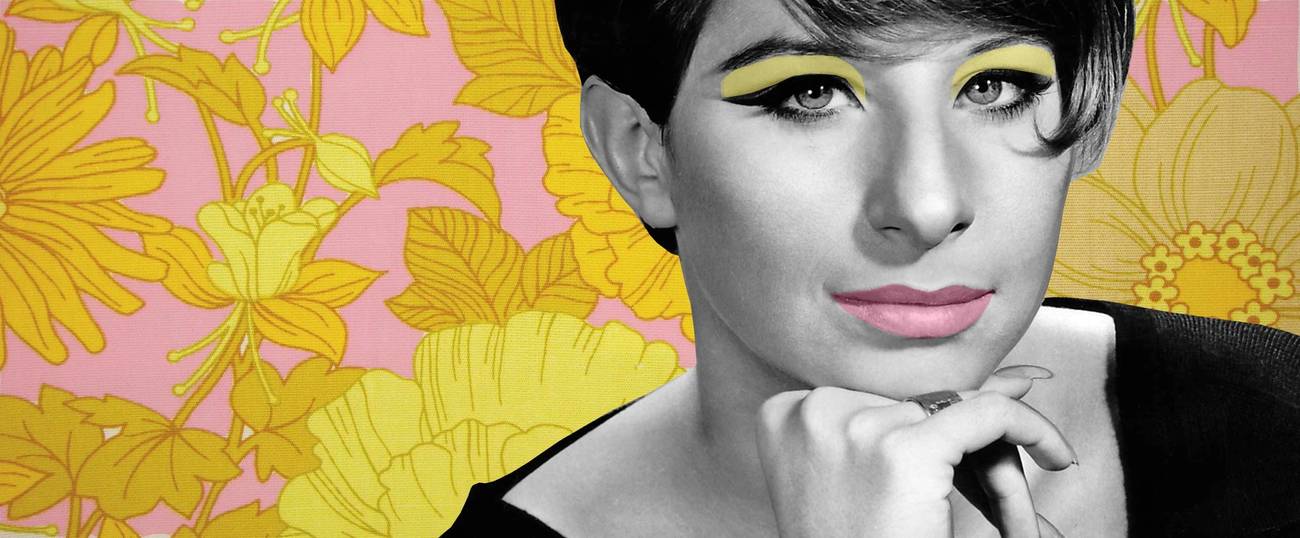Barbra Streisand Is Ready for Her Close-Up
Neal Gabler’s ‘impassioned’ new biography of the entertainer explores the paradox of modern Jewishness




The first time Barbra Streisand sang for an audience, she was still known as Barbara. It was July 2, 1960, and she had signed up to compete in a talent show at a Greenwich Village nightclub called the Lion. If Streisand’s life were a myth, this would be the scene in which she reveals herself as something more than human, a heroine or demigoddess capable of slaying monsters—or, in this case, the audience. She took the stage, Neal Gabler writes in his new book Barbra Streisand, in an oddball thrift-shop outfit, “a purple ostrich-feathered boudoir jacket over a dress of lilac and purple,” and sang the Harold Arlen song “A Sleepin’ Bee.” The result, as a friend recalled years later, was “a kind of stunned silence,” followed by “an eruption of yells and whistles, ear-shattering stomping and screaming.” Inevitably, Streisand won that night’s contest, and while celebrating afterwards, she announced that she was dropping the second “a” from her name: Barbara would become Barbra.
In dealing with an ordinary mortal, it might be excessive to read to so much into such a slight change. But in this short, impassioned biography, Neal Gabler insists that, when it comes to a star of Streisand’s dimensions, no amount of interpretation is excessive. Indeed, biography is not quite the right word for what Gabler is up to. Really, he is writing at the intersection of cultural studies and hagiography, poring over the episodes of Streisand’s life in order to expose their symbolic importance. For in the 20th century, the star became what biblical or mythic characters had been in earlier times, a person whose life served to crystallize and dramatize the great themes of human experience. “In effect,” Gabler writes, his book is “as much a biography of the metaphor that we have come to know as ‘Streisand’ as of the woman herself … Streisand is so much more than Streisand.”
In the 21st century, we no longer have this kind of relationship with stars. To be a metaphor requires a certain remote grandeur, which the celebrities of our age, from Donald Trump to Kim Kardashian, neither possess nor desire. But Streisand did desire it, ferociously, starting as a young, unhappy child in Brooklyn in the 1940s. “From the day I was born, I was trying to get out,” she later said, and she got out amazingly fast. At 14, she was a restless, solitary girl sitting in the audience of The Diary of Anne Frank, envying the lead, Susan Strasberg. At 19 she made her Broadway debut as Miss Marmelstein, the plain but dreamy secretary, in the musical I Can Get It for You Wholesale, and her big song stopped the show for a 3-minute ovation. At 20 she released her first album and told Newsweek that one day she would “win everything. The Emmy for TV, the Grammy for records, the Tony on Broadway, and the Oscar for movies.” (She did, one of only 12 people ever to do so.) A few weeks before her 22nd birthday, she opened as the lead in Funny Girl and was on the cover of Time. “Everybody knew that Barbra Streisand would be a star,” wrote Walter Kerr in his review of the show, “and so she is.”
Gabler’s book records all the landmarks in Streisand’s career, from those early Broadway hits and sold-out concerts, to the years in Hollywood starring in mostly bad but popular movies, to her emergence in the 1980s and 1990s as a director of films like Yentl and The Mirror Has Two Faces. Even her appearance in Meet the Fockers gets mentioned. Along the way, Gabler, one of our leading historians of film and popular culture, offers a number of penetrating observations about Streisand’s technique as a performer. As a singer, he writes, she “sang every single word with a different coloration and inflection. Think of how she sings the word ‘special’ in ‘People’: She punches the first syllable and elongates the second and gives it a beautiful onomatopoetic treatment that makes ‘special’ sound like something special.”
This idiosyncratic style makes Streisand, like Frank Sinatra, not just a singer but an actor of songs. It is also, Gabler observes, one of the qualities that made her seem old-fashioned, once the tidal wave of rock ’n’ roll crashed over American popular music in the early 1960s, just a year or two after her debut. Not that this dented her popularity—her albums were in the top 10 for decades—but it did mean that, while still quite young, Streisand already seemed to belong to an older generation in American culture. At 29 she lamented to Rolling Stone, “I’m labeled, pigeon-holed. I play for middle-class audiences in Vegas.” It’s hard to believe that she was born just a few months before Janis Joplin.
But if Streisand was never part of youth culture, she did enact, in her own way, the rebellion that was the great theme of the 1960s. The heart of Gabler’s book is his interpretation of what Barbra Streisand stood for, what her life and legend meant to her fans; and what they meant, above all, was a revolt against mainstream, 1950s standards of American beauty and stardom. The Streisand phenomenon was a referendum on whether someone who looked and sounded like Streisand could become famous. Her first critics and fans obsessed over her unconventional appearance—and for “unconventional,” of course, read “Jewish.” Could a Jewish woman, with an unreconstructed Jewish nose and an undisguised Brooklyn accent, win over the gentile public in the same way as Judy Garland or Doris Day? Could a Jew be a star?
Of course, Streisand was not the first Jewish star in Broadway or Hollywood—far from it. But she was, Gabler convincingly argues, “the first star who succeeded because of her Jewishness and not in spite of it.” Ingeniously, Streisand used a kind of judo technique with her Jewishness, turning what might have been considered a weakness into a strength—indeed, the centerpiece of her myth. In all her great roles, Gabler shows, Streisand played women who were too passionate, willful, commanding, and unusual—in short, too Jewish—to win or keep a man. Added to this was the idea of Streisand’s homeliness, which was connected with her Jewishness, and especially with her Jewish nose—a nose that was described by the famously vicious critic John Simon as looking “like Brancusi’s Rooster cast in liverwurst.”
It was as a preemptive strike against this kind of barely veiled anti-Semitism that Streisand defiantly sang, in “I’m the Greatest Star”: “Who’s an American beauty rose?/ With an American beauty nose?” “She simply decided to be beautiful, and now she is,” said the photographer Richard Avedon, and the idea that a person could will herself to be attractive—or talented, or famous—was central to Streisand’s myth. Older movie stars like Clark Gable or Vivien Leigh were so obviously gorgeous that they seemed to belong to a higher race of being. But when Streisand, in Funny Girl, greeted her reflection in the mirror with the words “Hello, gorgeous,” she was not just accepting her beauty; she was insisting on it.
Of course, Streisand did not entirely invent herself—she was born with the voice that was the basis for her fame. But perhaps for this very reason—because the voice was so obviously given, not made—she had ambivalent feelings about singing. Early on, she insisted that she was an actress, not a singer; singing was a kind of shortcut to the fame she wanted to earn. She never appeared on Broadway after Funny Girl, and after a 1967 concert in Central Park that drew 135,000 fans, she quit live performance for two decades. Even at the peak of her fame, Gabler shows, she remained insecure enough to be imperious and perfectionist—many said, simply impossible to work with. There was, in fact, a widespread rooting against Streisand in the movie business, an eagerness for her to fail. But this obstacle, too, served to enhance her myth. If Streisand was the outsider who came from Brooklyn to conquer Hollywood, then the hostility of Hollywood was only to be expected.
Gabler’s book appears in the Yale University Press “Jewish Lives” series, and appropriately so—Jewishness was absolutely central to her life and image. Yet Barbra Streisand also suggests that Jewishness, as an analytic category, is too fluid and multivalent—it can explain anything, which means that it explains nothing. At various times, for Gabler, Jewishness signifies unfemininity, ambition, “fantasy and emotion” (“By history, Jews had become expert in both”). Yet if you were to say that Jewishness also meant hypersexualization, unworldliness, and rationality, you could find evidence for those stereotypes, too. Really, what his analysis suggests is that Jewishness matters to Jews because we can never be sure which aspects of ourselves are being perceived as “Jewish.” This is the paradox of modern Jewishness, which Barbra Streisand—rather like Franz Kafka—turned into a universal metaphor. Gabler quotes Bernard Malamud: “All men are Jews except they don’t know it.” Listening to Streisand, they did.
***
Read an excerpt from Neal Gabler’s Barbra Streisand in Tablet magazine here.
Adam Kirsch is a poet and literary critic, whose books include The People and the Books: 18 Classics of Jewish Literature.